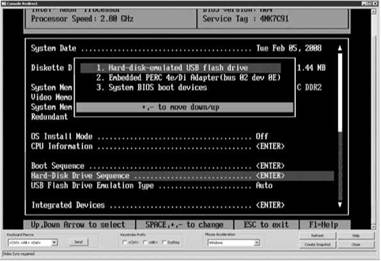Книга: Mastering VMware® Infrastructure3
Deploying ESXi Embedded
Разделы на этой странице:
Deploying ESXi Embedded
ESXi Embedded refers to the original equipment manufacturer (OEM) installation of ESXi onto a persistent storage device inside the qualified hardware. This is an exciting option that will save administrators the time of performing any type of installation. The embedded hypervisor truly allows for the plug-and-play hardware-type atmosphere. You can see that major server manufacturers are banking on this idea because their server designs include an internal USB port. Perhaps eventually the ESXi hypervisor will move from USB flash drive on an internal port to some type of flash memory built right onto the motherboard.
ESXi on Internal USB
At the time of this writing, there were no manufacturers selling the ESXi embedded. However, there were reports of agreements with major vendors like Dell and HP that each company would have several products available in Q2 of 2008. In my work with the good folks at Dell, they assured me it was coming soon but that further tests and design work had to be completed to ensure the security of the USB flash device on the internal port. Dell, like other manufacturers, puts all server designs through rigorous tests, including earthquake tests. Until they are confident that the products will withstand these rigorous tests, they have opted not to simply place a USB flash disk inside the system without some type of locking mechanism to ensure its placement. Perhaps a solution will have been devised by the time the book is published.
The installation files for ESXi Embedded are not available for public download; however, ESXi is available for download. It is suggested that only the OEMs will have access to the files necessary for building the persistent storage devices with the thin hypervisor installed. In best estimation, OEMs will be provided with a .dd file or an image file that can be extracted to the storage devices. For those who have been given access to the .dd file, it is possible to use dd.exe or WinImage to extract the installation files to a USB flash drive. The result is a bootable image of ESXi embedded onto the device.
When you purchase a system with ESXi Embedded, you only need to rack the server, connect the networking cables, and power on. The ESXi embedded on the persistent storage will obtain an IP address from a DHCP server to provide immediate access via console, VI Client, or VirtualCenter.
The server set to run ESXi Embedded must be configured to boot from the appropriate device. Take, for example, a Dell server with a USB flash drive with ESXi Embedded connected to an internal (or external) USB port. To run the thin hypervisor, the server must be configured to boot from the USB device. Figure 13.7 shows the BIOS of a Dell PowerEdge server.

Figure 13.7 To run the thin hypervisor of ESXi Embedded, the server must be configured to boot from the persistent storage device.
While this is just an example of using ESXi Embedded, the ideas and principles will be the same even when the system manufacturers finally get around to shipping the product.
Dell and ESXi
Based on my conversations and work with Dell in writing this chapter, Dell will add an internal USB connection in the next generation of the Dell PowerEdge server line.
At the time of this writing, ESXi Embedded was still not an option for purchase from the Dell website. Again, according to Dell the release of the product as an embedded feature will not occur until Dell has completed a period of rigorous testing that ensures system functionality and performance in even the harshest of conditions.
- Chapter 13 Configuring and Managing ESXi
- Using Double Quotes to Resolve Variables in Strings with Embedded Spaces
- Chapter 2 Building and Deploying a Run-Time Image
- Chapter 12. Embedded Development Environment
- Chapter 15. Debugging Embedded Linux Applications
- Practical Advice for the Practicing Embedded Developer
- 1.2. Embedded Linux Today
- 2.1. Embedded or Not?
- 2.2. Anatomy of an Embedded System
- 2.4. Embedded Linux Distributions
- 2.2.1. Typical Embedded Linux Setup
- Windows Embedded CE Standard Shell




